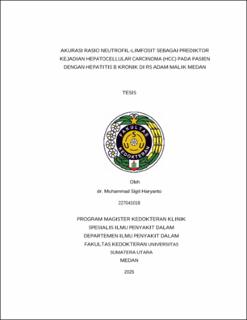| dc.description.abstract | Background Hepatocellular carcinoma (HCC) remains a major global health burden,
particularly in regions with high hepatitis B virus (HBV) prevalence such as
Indonesia. Despite advancements in antiviral therapies, the prognosis of HCC is often
poor due to delayed diagnosis.
Methods This study aims to evaluate the accuracy of the neutrophil-lymphocyte ratio
(NLR) as a predictive marker for HCC incidence among chronic HBV patients at Haji
Adam Malik General Hospital, Medan. A cross-sectional study was conducted
involving 255 chronic HBV patients, of whom 74 (29.0%) were diagnosed with
HCC. Clinical and laboratory data were analyzed using independent t-tests and ROC
curve analysis.
Results The NLR was significantly higher in the HCC group compared to the non- HCC group (7.16 vs. 3.25, p < 0.001). ROC analysis revealed an AUC of 0.785 for NLR, indicating good accuracy. At a cutoff value of 4.95, NLR demonstrated asensitivity of 73.0% and a specificity of 72.4% in predicting HCC incidence.
Furthermore, the NLR value ≥4.95 was associated with a notably higher proportion of
HCC cases (51.92%) compared to NLR <4.95 (13.33%).
Conclusions The findings support the utility of NLR as a simple, non-invasive, and
cost-effective tool for early risk stratification of HCC in chronic HBV patients.
Elevated NLR reflects systemic inflammation, which plays a pivotal role in HCC
pathogenesis via immune dysregulation, tumor promotion, and impaired antitumor surveillance. Given the promising predictive capacity of NLR, its incorporation into routine clinical assessments could improve early identification of high-risk individuals. However, further prospective and multicenter studies are needed to validate its applicability across broader patient populations. | en_US |


